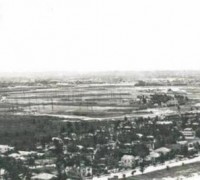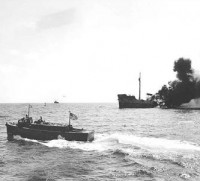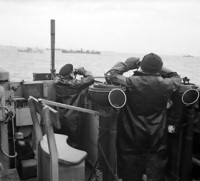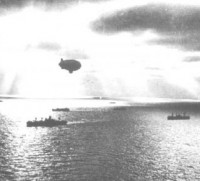- COMMANDER SOUTH ATLANTIC
18)THE PRESIDENTIAL VISIT
In mid-December, during the Admiral's absence at a Washington conference, submarine activity suddenly increased. Planes of VP-83 made four contacts in three successive days; December 13-14-15; and attacked each time. In three cases no evidence of damage to the German U-Boats, serious or otherwise, could be observed. In the other instance, that of December 14, an enemy sub of 750 tons, probably German, is believed to have been damaged by a plane piloted by Lieutenant Commander B. J. Prueher, commanding officer of VP-83. The U-Boat submerged at once and surfaced again, her conning tower showing a 15° list.
While these attacks all took place within a limited area and were spaced over several days, descriptions of the submarines furnished by the plane crews did not coincide at all, giving reason to believe that several underseas craft were operating in the vicinity. As a result, Comsolantfor, on December 15, ordered an "Alert" from Recife to Fortaleza, requiring blackouts and the temporary freezing of independent shipping. This continued for five days, the "All Clear" being sounded on the 20th.
In the meantime there had been another sound contact, resulting in a probable kill. This occurred on the 17th. A plane piloted by Lieutenant (jg) G. Bradford encountered a submarine in the act of surfacing in Latitude 06° 36' S, Longitude 33° 40' W. The U-Boat was attacked and straddled with three depth bombs. It rocked out of the water on the first, and then was completely covered by the explosions of the second and third. Four patches appeared; next the bow came out at a 45° angle dead in the water, then disappeared. About half an hour later there appeared on the surface a patch of oil, perhaps a mile distant, and two patches of discolored water a half mile away from the residue. Two Destroyers, the Davis and Humboldt, which were patrolling within reach, came up immediately and joined the search. Nothing more could be found or seen, and the general view taken was that the enemy had been destroyed.
The considerably increased submarine activity at this time caused the Admiral to request of the Cominch that an Attack Teacher, Sangamo type, be sent to Recife at the earliest possible date. He felt the need of giving officers and men more training in sound gear for anti-submarine work. He soon had the satisfaction of learning that the Attack Teacher would arrive via the supply ship Melville, scheduled to leave New York soon after the first of the year.
The Admiral's purpose in going to Washington was to confer with the Commander-in-Chief, U. S. Atlantic Fleet, and the Commander-in-Chief. The main subject of the interview was the convoy system operating between Trinidad and the Brazilian coastal areas. A new system of symbols to indicate planes and directions had been worked out. The importance of Bahia in the whole scheme of things are greatly enhanced. Shipping from Capetown and the south-east coast of South America would in the future be routed there for assembly, and ships bound for Capetown and the East would henceforth be dispersed from there.
Escorts would be made available as follows: the Destroyers Borie, Barry, and Goff from the Pacific Sea Frontier; seven patrol vessels, either Gunboats or Yachts; ten Submarine Chasers from the Caribbean Sea Frontier; and five Destroyers from Task Force Twenty Three. This made a total of twenty five escorts; the plan being to divide them into five groups of four each, thus leaving a reserve strength of 25% as spares. It was also contemplated that Brazilian ships would be available for part of the convoy work, particularly on the run between Recife and Bahia. If so, the American escorts could be based on Recife.
The Admiral, who knew the condition of the Brazilian ships, stated that only three of them had sound gear as yet. Therefore, whenever the submarine situation was bad south of Recife, American escorts should continue on with the run to Bahia. In view of the still limited facilities for supply and storage of fuel at the latter port, Admiral Ingram considered it best for Tankers to be included in the convoys. He could not give an optimistic report on he Bahia repair facilities, but estimated that the situation could somehow be handled.
As a matter of fact, the first Bahia-Trinidad Convoy (designated BT) assembled on January 12. For five months, subsequent ones continued to run out of Bahia, until the shifting of the assembly point to Rio in June. The number of ships reporting to the South Atlantic Force in December was larger than usual. Newcomers and returning vessels included the Cruiser Savannah, the Destroyers Kearney, Bore, Ericsson, Livermore, and Goff, the Aircraft Carrier Escort Santee, the Gunboats Surprise, Tenacity, and Spry, the Yacht Carnelian, and three PCs, numbered 489, 564, and 610.
Also reporting was the Seaplane Squadron VP-74, which was based along with VP-83 at Natal. The new squadron immediately had engine trouble. At first there was some thought of returning the seaplanes to Trinidad. At length, however, the decision was to retain them in their present duty. They were the Mariner Type planes and many squadrons of these had already been scheduled for this type of duty at advanced bases. In order to find out just what their efficiency might be, it seemed best to keep them at their assignment.
Nevertheless, the squadron's situation grew worse steadily, and early in February the Admiral had to forward a recommendation to Admiral Ingersoll that VP-74 be recalled to the United States and a replacement squadron of seaplanes be sent. It being impossible to comply with this request at once, the squadron remained at Natal for several months more.
At the beginning of 1943, then, we find the South Atlantic Force greatly augmented in strength, with permanent shore headquarters, and with several land bases and airfields, in various stages of completion. In organization there now existed a departmentalized administration, with seasoned officers heading the departments. Captain (later Commodore) Clinton E. Braine had been Chief-of-Staff for several months. Rear Admiral O. M. Read commanded Cruiser Division Two, while Destroyer Squadron Nine and Convoy Escorts were under Commander H. C. Robinson. Captain W. N. Thornton, Fleet Material Officer, had charge of repairs, Captain G. R. Will was Operations Officer, and Fleet Training came under Captain A. C. Converse.
When, a little later, Fleet Air Wing Sixteen was attached to the Admiral's command, Captain R. D. Lyon arrived as Wing Commander. For January, the outstanding event by far was the visit of the President of the United States. On his way to the Casablanca Conference with Prime Minister Churchill and the French leaders, the President passed through Belem. Here he conferred with Admiral Ingram, displaying a keen interest in the Brazilian situation. He instructed the Admiral to arrange a meeting for him with President Vargas at Natal on his return from Africa, and added that he desired Ambassador Caffery to be there too.
Admiral Ingram made all of the arrangements. He had the Tender Humboldt and the Destroyer Leader Jouett at Natal to provide accommodations for the distinguished visitors. He flew to Rio in person to escort the Brazilian President and various members of his staff to the conference, arriving there on January 18. Nine days later the party left the Brazilian Capital, bound for Natal. Aboard the plane were the President of Brazil, Senhor Cetulio Vargas, Ambassador Jefferson Caffery, Vice Admiral J. H. Ingram, Rear Admiral A. T. Beauregard, Major Schultz, Captain Pomponi and Commander Cunha of the Brazilian Navy, Lieutenant Ingram, the Admiral's son, now serving as his Flag Lieutenant, Lieutenant Andrade of the Brazilian Navy, and Senhores Fortunato and Capuli. They reached Natal that evening, and President Vargas was quartered aboard the Jouett, where he was tendered a dinner by Admiral Ingram.
The following morning at 0800 two planes arrived, bearing the President and his party, which included Mr. Harry Hopkins, Rear Admiral R. McIntyre and Captain J. McCrea. This was the first time the two presidents had ever met, and they got along well together. The President of the United States was quartered aboard the Humboldt, where at noon he entertained President Vargas at lunch.
They spent the afternoon making inspections; first of the VP-74 seaplane base, and then Parnamarim Field, where Squadrons VP-83 and 94 were quartered. They concluded by visiting the Army and Brazilian Air Facilities. Accompanying the Presidential parties on their tours were the Interventor for the State of Rio Grande do Norte, the Admiral in command of the Naval Base at Natal, and Brigadeiro Gomes of the FAB. In the evening the President of Brazil dined aboard the Humboldt with the President of the United States, and after diner the two had a conference.
Both left the following day. Before daylight the American President was taken from the Humboldt to Parnamarim Field, from which he and his party flew to Trinidad. A few hours later the Vargas group left the Jouett for the same field to depart for Rio, escorted by Admiral Ingram and General Walsh. At once the Humboldt and Jouett got under way to proceed on regular patrols. The Force had not enough ships at this time to spare them for long.
At the time of the Presidential visit, Admiral King was also in Brazil for a brief inspection tour, though he did not accompany the official party. He visited Recife alone and while there inspected all Naval activities at Base Fox. The Commander-in-Chief had very little time for social activity, though he did exchange a round of calls with Brazilian officials. He also talked with officers of several American ships in port and seemed favorably impressed with what he saw.
Hyper War. Commander South Atlantic Force. U.S Naval Administration in WW II.



